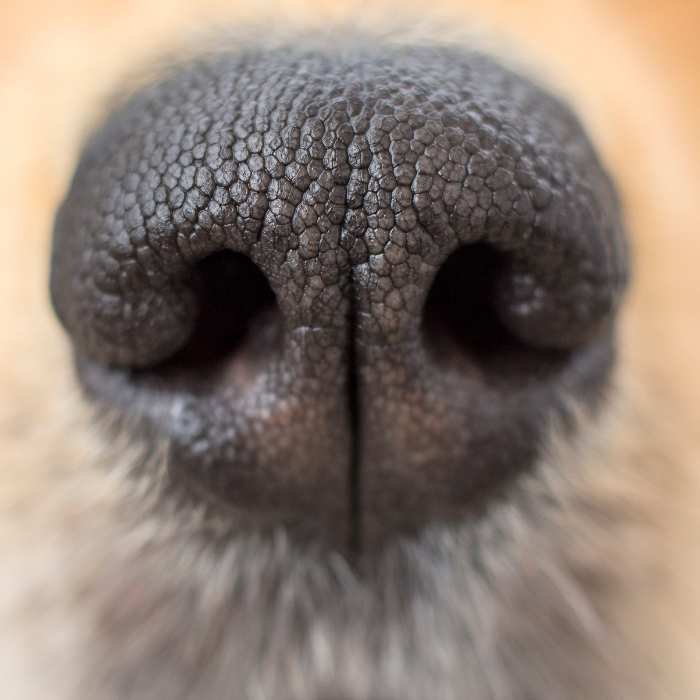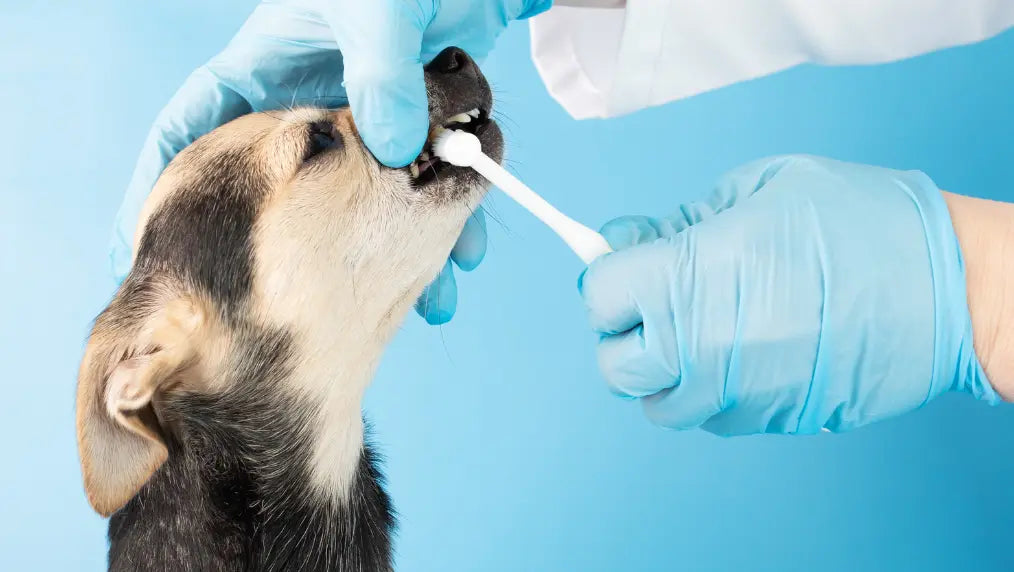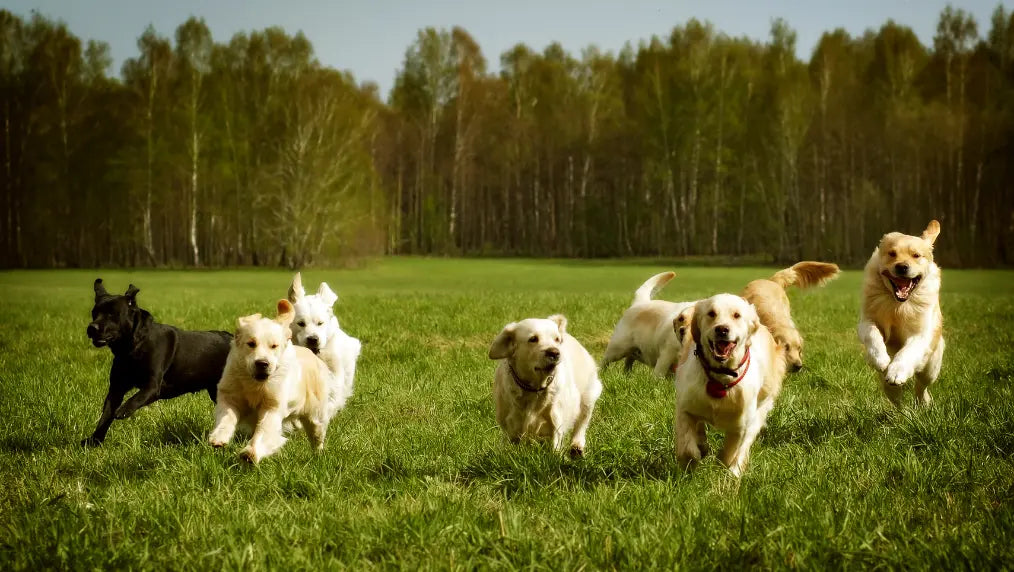Dogs are often referred to as man's best friend, and part of what makes them so remarkable is their extraordinary sense of smell. What do dog noses have that humans don't? They possess up to 300 million olfactory receptors in their noses, compared to about six million in us. And the part of a dog's brain that is devoted to analyzing smells is about 40 times greater than ours. Dogs also have something called neophilia, which means they are attracted to new and interesting odors.
It's no exaggeration to say that a dog's olfactory abilities are nothing short of miraculous. In this blog post, we'll delve into the fascinating science behind a dog's sense of smell, exploring its anatomical features, physiological processes, and the mind-boggling capabilities that make it one of the most powerful tools in the animal kingdom.

Why Are Noses Important to Dogs?
The canine nose does more than smell the roses. While humans primarily depend on their vision, dogs use both sight and smell to assess their surroundings and communicate. People spend more time interpreting visual data than olfactory information. Dogs are just the opposite.
Dogs devote lots of brain power to interpreting smells. They have more than 100 million sensory receptor sites in the nasal cavity compared to 6 million in people, and the area of the canine brain devoted to analyzing odors is about 40 times larger than the comparable part of the human brain. In fact, it has been estimated that dogs can smell anywhere from 1,000 to 10,000 times better than people.

Do Dog Noses “Talk”?
While noses do not actually speak, they do communicate. With a single sniff, noses interpret an entire story without words by using amines and acids emitted by dogs as the basis for chemical communication. The chemical aromas communicate what a dog likes to eat, and identify gender and mood. By simply smelling, a dog can determine if a new friend is male or female, happy or aggressive, healthy or ill. Dogs get a general idea about each other with a quick sniff, but get more detailed information by getting up close and personal. That is why some dogs sniff private parts of the anatomy!
Dogs also have a good scent memory that can identify other dogs they have not seen for years, and even remember which of them was the dominant member of the pair. When dogs belonging to the same family are separated for a while, they use their sense of smell to catch up on things. Changes in odors may convey where the dog went, what he ate, and what he did.
When in a new territory, a dog can sniff a tree and determine what other dogs live in the neighborhood. They can smell a visitor’s pant-leg and get a good impression of where the person lives and whether he has pets at home.
Dogs also have a great homing instinct that depends on their ability to smell. Since dogs move their nostrils independently, they can determine the direction of an odor and use their sense of smell like a compass.

The Anatomy of Canine Olfaction
Dogs possess an astonishing number of olfactory receptors in their noses. Unlike humans, who have approximately 5 to 6 million, dogs boast an impressive range of 220 to 300 million olfactory receptors. This allows them to detect scents at incredibly low concentrations, making their sense of smell roughly 10,000 to 100,000 times more acute than ours.
The olfactory epithelium is a type of pseudostratified columnar epithelium involved in sensing smell. It lines the olfactory cleft of the nasal cavity and forms one of the major components of the olfactory mucosa, with the other being the lamina propria.
Also known as the vomeronasal organ, this specialized structure enhances a dog's ability to detect pheromones, chemical signals that convey important information between individuals of the same species. It's located at the base of the nasal cavity and plays a crucial role in social interactions and reproductive behaviors.
The olfactory bulb is a vital component of a dog's brain responsible for processing and analyzing scent information. It's disproportionately large compared to other mammals, occupying a significant portion of the canine brain. This is why a dog's sense of smell is so deeply ingrained in their cognitive functions. Dogs have an uncanny ability to differentiate between a wide variety of scents. They can identify specific odors even when they are mixed with other odors, showcasing their exceptional discrimination skills. This talent is the foundation for activities like search and rescue, tracking, and scent detection work.

Why Do Dogs “Smell Better” Than Humans?
Unlike humans, dogs have an additional olfactory tool that increases their ability to smell. Jacobsen’s organ (or the vomeronasal organ) is a special part of the dog’s olfactory apparatus located inside the nasal cavity and opens into the roof of the mouth behind the upper incisors. This amazing organ serves as a secondary olfactory system designed specifically for chemical communication. The nerves from Jacobsen’s organ lead directly to the brain and are different from the other nerves in the nose in that they do not respond to ordinary smells. In fact, these nerve cells respond to a range of substances that often have no odor at all. In other words, they work to detect “undetectable” odors.
What Can a Dog Smell
So a dog’s olfactory organ is pretty on point, but what can a dog smell? Can dogs smell cancer?
There have long been stories about pets seeming to detect when people are sick, but in more recent research we have actually started to put some science behind the rumors. In 2014, Dr. Gianluigi Taverna actually was able to publish a study in which two German shepherd dogs were trained and able to detect prostate cancer by smelling human urine samples with 98% accuracy
There is also evidence that dogs can use their sense of smell to detect conditions including:
-
Diabetes
-
Oncoming seizures
-
Parkinson’s disease
-
Various cancers including lung, bladder, ovarian, melanoma, and breast
Scientists are even starting to try to determine what dogs are smelling to tip them off to trouble so that we can one day detect odors that indicate these types of conditions in a laboratory setting.
The Practical Applications of a Dog's Sense of Smell
1. Search and Rescue
Trained dogs play a crucial role in search and rescue operations, where their keen sense of smell enables them to locate missing persons even in challenging environments. Their ability to detect the subtlest scent cues can mean the difference between life and death in critical situations.
2. Detection Work
From detecting explosives and narcotics to identifying diseases like cancer, trained dogs and service dogs have been trained to use their olfactory prowess in a wide range of professional settings. Their accuracy in identifying target scents is unparalleled by any man-made technology. A dog's nose can detect human blood, scent molecules, increased heart rate, behavioral responses and other specific scents.
3. Hunting and Tracking
In the wild, a dog's sense of smell is an invaluable tool for hunting and tracking prey. Domesticated dogs often retain these instincts, making them excellent companions for hunters. Trained dogs have an even higher smelling ability.
Communicating Through Smell

While humans typically use our words to communicate and our eyes to take in the world around us, dogs rely more heavily on body language and smell.
Dogs rely on their sense of smell using the Jacobsen’s organ to find a mate, locate their family members, seek out food, and avoid predators. You’ve likely witnessed your pooch engage in a heavy sniffing session when he meets another dog. Dogs greet each other through sniffing, but it’s so much more than a simple “hello.” A dog's nose and their sense of smell help them learn each others’ sex, age, health, recent meals and encounters, and even their mood.
When a scared or ashamed pooch lowers his tail between his legs, it’s actually related to smell: the lowered tail can cover up some of the scent released from anal glands, making him less noticeable to others. On the contrary, a dog with a raised tail may be trying to release more of his smell in order to establish dominance.
Dogs can even sniff out diseases and detect human emotions through smell. If you feel sick or down in the dumps and you notice your furry best friend acting more loving than normal, it’s not just a coincidence—dogs can smell hormone production, rises and falls in blood sugar levels, and even changes in brain chemicals. Some dogs are specifically trained to work as emotional support or service animals; even without that training, though, your pup is able to naturally pick on moments when he may feel the need to provide you with some extra support and affection, just as you would do for him.
Why Do Dogs Have Wet Noses?
The canine nose works best when it is damp. The wet outer nose and mucus-covered nasal canal efficiently capture scent particles. Moisture is so important to the canine sense of smell, that dogs will lick their noses when they become dry. Smart canines do not want to miss out on important information due to a dry nose!
Conclusion
A dog's sense of smell is an awe-inspiring phenomenon that sets them apart in the animal kingdom. Their specialized anatomy, advanced neurological processes, and remarkable scent discrimination abilities make them true olfactory marvels. Understanding the science behind a dog's sense of smell not only deepens our appreciation for these furry companions but also highlights the incredible potential they hold in various fields, from search and rescue to medical detection. It's a reminder that our canine friends are not only loyal companions but also astonishing gifted beings.





